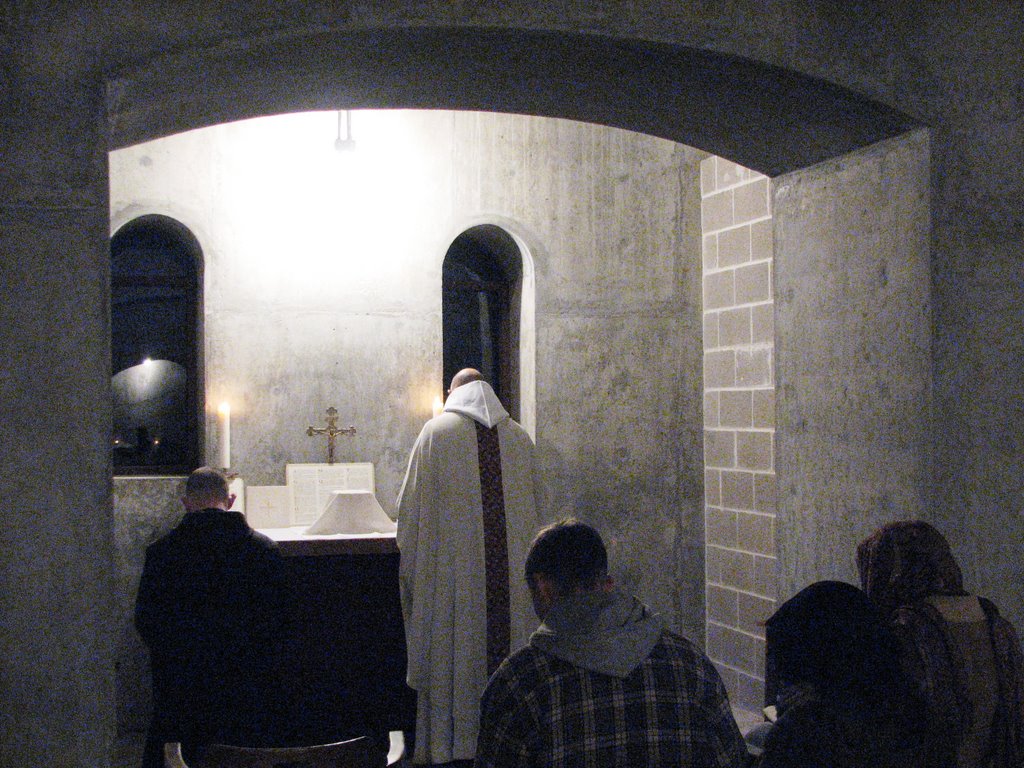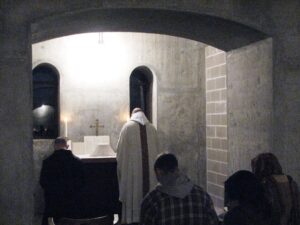The Church lays down a minimum for attending Mass and receiving the Eucharist.
The Church obliges the faithful to take part in the Divine Liturgy on Sundays and feast days and, prepared by the sacrament of Reconciliation, to receive the Eucharist at least once a year, if possible during the Easter season (CCC 1389).
But what would striving toward the maximum look like? The same point from the Catechism of the Catholic Church immediately adds:
But the Church strongly encourages the faithful to receive the holy Eucharist on Sundays and feast days, or more often still, even daily.
So a reasonable objective for a Catholic, who is already attending Mass each Sunday and receiving Holy Communion in a state of grace, could be to attend one more Mass each week.
An ideal would be to attend Mass and receive Communion daily.
Who goes?
I have been doing this for over thirty years. When I was thirty, it seemed like I was always the youngest person there. It was the case then and still is today that daily Mass is mostly attended by retired persons. This makes sense in terms of what I just heard a wise priest say: “The purpose of old age is to pray.” There is so much to pray for!
Still, I am very gratified to see men begin their day with Mass before heading off to do their professional work; young mothers with their very young children; even young single persons and teenagers attending, just because they want to.
I’d like to propose that some parishes provide a way for non-retired people to more easily attend Holy Mass daily. This will be a Mass that will be convenient, beautiful, reverent, without any hurry whatsoever, and celebrated during the noon hour: the 18-minute Mass.
The 18-minute Mass
Here is something a lot of people don’t know. The Novus Ordo stripped to its bare essentials is very beautiful. If celebrated simply it can be very reverent and edifying. What do I mean by bare essentials? Drop the hymns, take out the personal greetings and commentaries, eliminate the lectors, omit the prayers of the faithful and offertory procession, place the credence table close to the altar, leave off the Kiss of Peace, and distribute communion under one species. What is left takes very little time. There is lots of silence. The beauty of the words and readings, of the gestures, vestments, and vessels comes to the fore. There need be no hurry whatsoever.
What about the homily? It is not required, but most who assist at Mass would be very happy to have a one or two minute, carefully prepared, pithy homily that makes one important point.
What’s the benefit?
Why should we want to attend Mass more frequently ourselves and to see more Catholics do the same? Here’s why. Ours is a sacramental religion. We require grace and we get it mostly from the seven sacraments. The greatest of these and our daily bread is the Eucharist. Add to this the opportunity to hear the Sacred Scriptures and to pray for everyone and everything.
Schedules
Why not make the Mass more accessible? Witness the Monday through Friday Mass schedule for St. Peter’s in the loop in Chicago: 6:15, 7:15, 8:15, 11:40 a.m., 12:15, 1:15, 5:00 p.m. These Masses are short without being hurried and are geared for commuters arriving and departing the suburbs by train or able to slip away from their offices. Not every parish need do this. Just one that is easy to get to.
Assuming our busy, non-retired Catholic has an hour for lunch, her schedule would be something like this:
- 12:00 – 12:10: Leave for Mass
- 12:10 – 12:30 Assist at Mass
- 12:30 – 1:00 Eat some lunch, maybe run an errand, and get back to her other business.


Leave a Reply